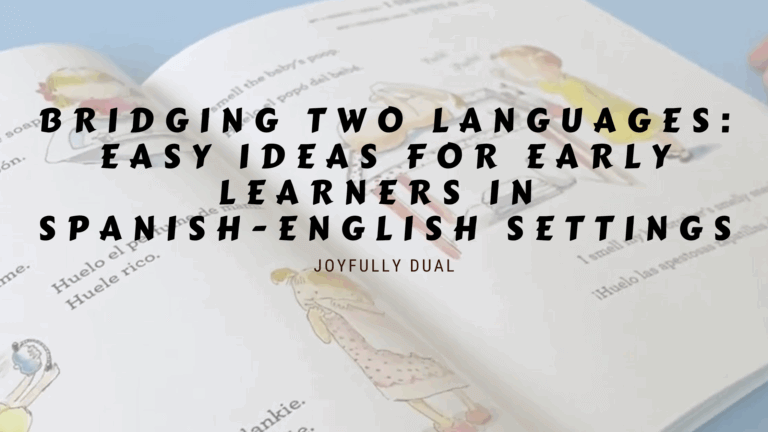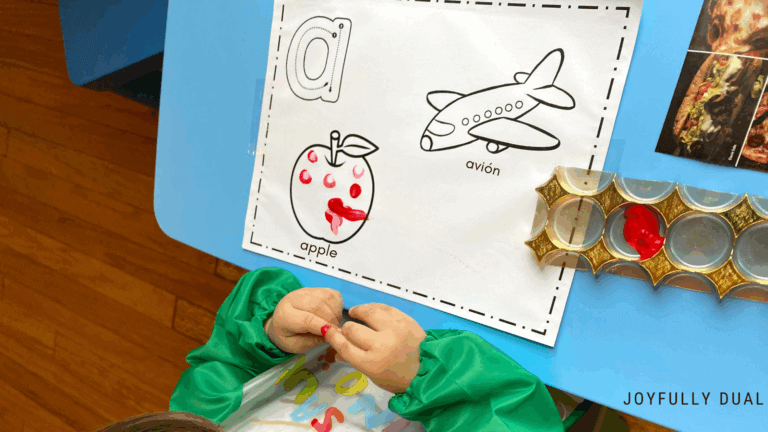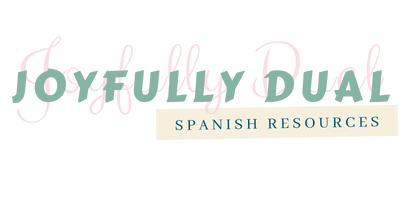
If you teach or raise young bilingual learners, you may wonder how to begin nurturing both languages at once. One of my favorite ways is by using a powerful strategy from bilingual education called “The Bridge”.
Even for toddlers, preschoolers, and early readers, you can start building bilingual connections. I use these strategies at home with my kids, and they work beautifully to grow confidence, awareness, and curiosity in both Spanish and English.
What Is “The Bridge” for Little Learners?
In early bilingual learning, The Bridge is a simple, intentional way to connect ideas, vocabulary, and sounds across Spanish and English. It’s not about strict translation. Instead, it’s about noticing similarities and differences between both languages.
It may sound like play, and that’s the point! When done in age-appropriate, interactive ways, The Bridge becomes a fun, natural part of everyday learning.
Why The Bridge Works with Early Learners
When we use The Bridge consistently:
- Encourages kids to think about language
- Builds vocabulary in two languages at once
- Strengthens phonological and phonemic awareness
- Lays the foundation for future reading and writing in both languages
- Makes bilingual learning fun and developmentally appropriate
😊 Start small, keep it playful, and build bridges through routines, songs, and stories.
In our home, I’ve used The Bridge to help my kindergarten compare and connect letter sounds in Spanish and English. His eyes light up when he makes those connections, and he begins to feel proud of his bilingualism.
Bridging Strategies for Early Readers and Learners (PreK–2nd Grade)
Here are some strategies to incorporate The Bridge for early learners:
1. Use Real Objects and Pictures
Show a real object or a picture, and name it in both languages. Let children repeat and compare.
Example: “This is a manzana. In English, it’s apple. Do they sound the same?”
2. Sing Songs and Rhymes in Both Languages
Use bilingual songs or sing the same song in Spanish and English.
Example: Sing “Cabeza, hombros, rodillas y pies” and then “Head, Shoulders, Knees and Toes.” Discuss the body parts and how they sound in each language.
3. Bridge Alphabet and Letter Sounds
Young children are learning how letters and sounds work. Compare letters across languages.
Example: “The letter A says /a/ in abeja. In English, A can say /ae/ like apple or /ei/ like acorn.”
Use alphabet flashcards with a word in both languages:
- L: León / Lion
- E: Elefante / Elephant
4. Label Your Environment
Label common items in your classroom or home in both Spanish and English. Refer to them during daily routines.
Examples:
- puerta / door
- silla / chair
- libro / book
Ask questions like: “Do these words sound the same or different?”
5. Use Puppets or Pretend Play
Use two puppets or dolls. One speaks Spanish, the other English. Let them “talk” about their day or favorite toy.
Example: “Mr. Oso says ‘oso’… Mr. Bear says ‘bear.’ Same animal!”
6. Clap Syllables and Play With Sounds
Clap the syllables of words in both languages. Compare lengths, sounds, and rhythms.
Example: ma-ri-po-sa and but-ter-fly both have 4 syllables!
Sort pictures by beginning sound across languages:
- gato / goat (initial /g/)
- sol / sun (initial /s/)

Early learners are natural explorers of sound and meaning. When we introduce The Bridge early, we plant the seeds of metalinguistic awareness and bilingual confidence.
Keep it simple, sensory, and joyful. Even the smallest bridging moments can spark a lifelong love of both languages.
Let’s raise curious bilingual thinkers one song, one story, one bridge at a time.
Related Post:
👉 How to Use The Bridge in Bilingual Classrooms and Homeschool Settings
